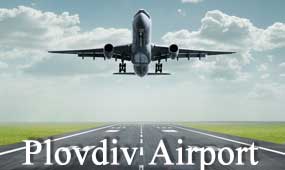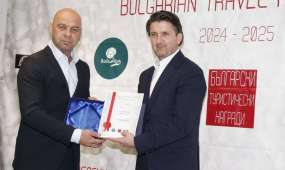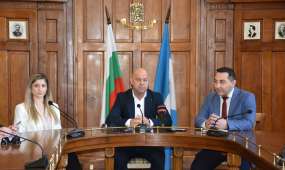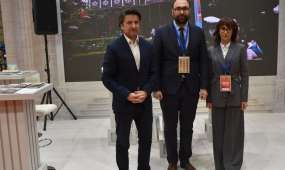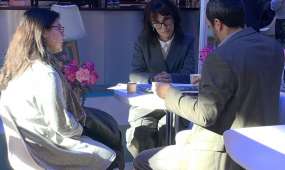Exposition The Unification of Bulgaria of 1885
phone: +359 32 629 409 email: [email protected] link: http://historymuseumplovdiv.org/front/index.php?lng=enExposition „The Unification of Bulgaria of 1885” has been arranged in the building of the Province assembly (the Parliament) of East Rumelia. The building was designed by Architect Pierre Montani and is now one of his most significant creative accomplishments. Born in the department of Savoy, he was one of the numerous community of foreigners who settled in Plovdiv after the Russo-Turkish war (1877-1878). The building was under construction from 1883 to 1885 under the guidance of Architect Oscar Lefait. A spacious assembly hall was designed for the delegate sessions and the side wings were meant for the administration. On 6 September 1885 the Unification of East Rumelia and the Principality of Bulgaria was proclaimed, and as Sofia became the capital of the unified Bulgarian state, the building was deprived of its initial designation. In March 1886 the Prime Minister Petko Karavelov ordered the building to accommodate the Plovdiv Public Library and Museum. It had been the most important cultural institute in Plovdiv for nearly 100 years. In 1895 the Commercial and Industrial Chamber of Plovdiv was founded there, the Association of South Bulgarian Artists was created in 1912, and the first art exhibitions were organized. Down the years the authentic appearance of the building was preserved and now it is still one of the cultural centres of Plovdiv.
The museum exposition „The Unification of Bulgaria” was opened in 1985 on the occasion of the 100th anniversary of the Unification of the Principality of Bulgaria and East Rumelia, an event which has become a national symbol of our new history. The exposition represents the period beginning with the Treaty of Berlin (1878), which dismembered the Bulgarian-populated lands into five parts, till the Serbo-Bulgarian War of 1885. Focus is put on the setup and development of East Rumelia as the Second Bulgarian state, preparation and implementation of the Unification with the Principality of Bulgaria on 6 September 1885. Five exhibition halls on area of 900 m2 show authentic exhibits (personal belongings, award tokens, cold steel and firearms), photos and documents of participants in the Unification and the Serbo-Bulgarian War. The preparation and realization of the Unification was an act of the whole Bulgarian public, a unique example of common action of the masses and their leaders. The Unification indicated the vitality, endurance and increased self-respect of the Bulgarian people. After its recognition, the Bulgarian state expanded significantly not only its territory and population, but also its influence before the Great Powers and the Ottoman Empire for a final solution of the Bulgarian national issue: the unity of all lands inhabited by Bulgarians in one single Motherland.
Museum Exposition
9th Infantry Regiment of Plovdiv in the Wars for National Unification
Is it necessary and in what way our military
history is to be shown in the expositions of the regional museums of Bulgaria? In such a way as to be different in Plovdiv, Sliven, Burgas, Varna, Ruse, and yet to show the truth of the Bulgarian wars for national unification. We, in the History Museum of Plovdiv, have taken a keen interest in this question for many years, as an answer was found while we were making preparations for the celebration of 125th anniversary of setting up 9th Infantry Regiment of Plovdiv. Its precise name was in fact “9th Infantry Regiment of Her Highness Princess Klementina”. It was founded at the end of 1885 after the Unification of the Principality of Bulgaria and East Rumelia as a result of the military territorial division of the country and the regimental arrangement. It was recruited in the region of the nowadays Plovdiv county, excluding the region of Karlovo, Parvomay and Asenovgrad, and has become a symbol of the martial courage of the people of Plovdiv and the neighbouring communities. In such a way, the soldiers of a company came from close settlements, knew each other, shared together the hardship of army life, and stood by each other in the hard times of battle. The regiment was successor of the glorious traditions of 4th Volunteer’s battalion which encamped in Plovdiv after the Liberation; of 2nd Battalion of the East Rumelia’s militia which under the commandment of Major Danail Nikolaev proclaimed the Unification of Bulgaria on 6 September 1885 and participated in its military defence at Slivnitsa.
In the exposition which we opened on 21 June 2011 within the building of the Museum at 1 Saedinenie Square in Plovdiv, we display the preparation and participation of the Regiment in the wars for national unification. Thanks to the idea of Colonel Vasil Delov, who was at the head of the Regiment at the end of the nineteenth century, we are able to show photo material of very high quality of officers, soldiers, their drills and life in the barracks of the Regiment, i.e. the image of the Bulgarian soldier. Among the military archives and our collections we have discovered photos of life at the frontline which put their stamp on times and locations of glorious victories: the liberation of the Rhodopes and the Aegean region, and the officers of the Regiment at Şarköy of the Marmara Sea during the Balkan War; the short and yet bloody battles at the Serta Mountain and Krivolak during the Second Balkan War when the Regiment took part in the complete defeat of the Serbian Morava Division; the first defence of Dojran and the combat at the Cerna Bend during the First World War when in uninterrupted battles the Regiment lost a great number of its soldiers and officers, and the lieutenants took the command of the battalions; the heroic battles at Deve Bair, Kriva Palanka, Strazhin, Stracin and Kumanovo during the Second World War.
The greatest interest is undoubtedly attracted by the collection of weapons which the Regiment was armed with from the time of its establishment till 1955 when it was disbanded, as well as trophies: a Turkish flag captured by the Rhodope battalion in 1912, rifles, guns and uniforms. No less is the interest towards the orders and medals worn by the war heroes, the pictures of the army artist Hristo Stanchev, the instruments of the army surgeon Dr. Mihail Krastev, the “military works of art” made by soldiers in the trenches of the First World War. To make the exposition more interesting to children, we created a replica of a command post of the Regiment dated 1917 when it was headed by the legendary Colonel Boris Drangov. There one can see the original officer’s camp bed, the Regiment’s typewriter and a telephone.
An evidence of the topicality of this museum exposition was the public interest demonstrated already in the process of its preparation. We witnessed some moving gestures made by former soldiers and officers of the Regiment and their successors who granted the key of the Regiment’s barracks and trophy weapons (Colonel Genko Chelibakov); the manifesto on entry of Bulgaria into the First World War read before the Regiment in October 1915; the complete set of photos owned by Colonel Ivan Bonev, commander of the Regiment during the Patriotic War (his son Dr. Bonyu Bonev); the photos of General Nikola Genchev, commander of 2nd Infantry Division (his son Professor Lyubomir Genchev), and still many more other exhibits. Tens of people came to ask for clarification of the fate of their grandfathers and fathers – perished soldiers of 9th Infantry Regiment or of the other regiments of the Bulgarian army.
This exposition shows one of the approaches which modern museums should apply while searching for their own concept of the Bulgarian military history. It should have an intriguing and diverse presence in their expositions because each infantry, cavalry or artillery regiment keeps innermost secrets of our past. We, Bulgarians, should be proud of and not forget the military heroic deeds of our ancestors. When in a military hospital after the capture of the Edirne Fortress they asked a soldier with an amputated arm why he was so smiling and elated, he answered: “Yes, my arm is now shorter, but Bulgaria became greater!” That is really the way to build up Bulgaria.
Day for free visit: Every first Thursday of the month for students and retired people.





